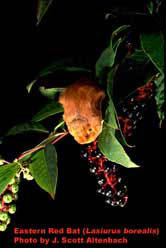During the fall of 1920, something curious happened on the Atlantic Ocean. The captain of a small ship traveling about 20 miles from the coast of North Carolina reported that a flock of nearly 100 bats landed on his boat. Not only were these strange visitors bats, but also the flock was composed of two entirely different species. What were bats doing so far out at sea? Were they migrating? Where were they going?
Since the early part of the 20th century there have been several accounts of bat flocks appearing in strange places at strange times. However, our understanding of bat migration has advanced little since that day in 1920 when the ship captain must have puzzled over the arrival of his unusual visitors.
In hopes of learning more about the migratory habits of bats, USGS biologists Paul Cryan and Michael Bogan from the Arid Lands Field Station teamed up with USGS geochemists Robert Rye and Gary Landis of the Denver Stable Isotope and Gas Chemistry Laboratory in a study that applied new research techniques to the poorly understood phenomenon of bat migration.

Forty-five bat species inhabit the United States and many make short-distance movements between summer and winter quarters. However, four of these species may have longer migratory pathways than any other terrestrial mammal in the Northern Hemisphere. These four species, commonly referred to as "tree bats" because they roost in the foliage or trunks of trees, are hoary bats (Lasiurus cinereus), eastern and western red bats (L. borealis & L. blossevillii, respectively), and silver-haired bats (Lasionycteris noctivagans).
Each year, tree bats are encountered at latitudes above 38° in North America during the summer but are mostly absent during the winter. Despite this seasonal occurrence and many observations suggesting migratory activity (e.g., landing on ships at sea and on remote islands), the details of their seasonal movements are poorly understood. Unlike birds, few people ever see tree bats, making it very difficult to determine where they are at any given time. Compounding this problem is the fact that there have been no successful attempts to follow individual tree bats over the immense distances they likely travel because traditional methods of following volant animals (e.g., banding, radio tracking) are inadequate. It is crucial that more efficient means of studying bat distribution and migration are developed because the conservation of bat populations is contingent upon a thorough understanding of the spatial and temporal distribution of species.
Recently, biologists and geologists have begun to analyze stable isotope signatures in biogenic materials (e.g., feathers, bone) to track the origins of migratory animals. One element that is useful for such analysis is hydrogen. The stable-hydrogen isotope ratio of local precipitation and groundwater is relatively constant in a localized area, but changes with latitude and elevation. In general, the isotope ratios of local precipitation are incorporated into the tissues of animals inhabiting that area.
Recent work with migratory birds enabled researchers to determine the geographic origins of feather tissue collected on wintering grounds, because feathers are grown before the birds migrate and isotope ratios in feather tissue reflect ratios of the areas where the birds spent the breeding season. Mammal fur and bird feathers both incorporate hydrogen in a similar manner during growth and bats, like birds, molt into new fur before migration.

This project determined the efficacy of using stable isotope analysis on bat fur. In addition to testing the basic assumptions of the technique, we analyzed potential patterns of movement by hoary bats with the help of an occurrence record database and a geographic information system (GIS). The GIS database, with more than 10,000 historical occurrence records of several species of tree bats, helped us determine the potential direction and distance of migratory movements by hoary bats
Our research represents the first application of stable-hydrogen isotope methods to bat migration and provides direct evidence of long-distance movement by hoary bats. In some cases, isotopic evidence indicated that the minimum distance traveled between the site where bats grew their fur and where they were captured exceeded 2000 km. These results reveal that stable isotope analysis is a promising new way to study bat migration. Due to our general lack of knowledge regarding tree bats, there is no consensus on the status of most species. At our current level of understanding, population declines may go unnoticed. With an improved understanding of the wintering and summering grounds, migratory routes, breeding areas, and dispersal abilities of tree bats we will be in a much better position to insure their future protection.
For more information, please contact:
Paul Cryan
U.S. Geological Survey
Fort Collins Science Center
2150 Centre Avenue, Bldg C
Fort Collins, CO 80526-8118
phone: 970.226.9389
fax: 970.226.9230
email: paul_cryan@usgs.gov